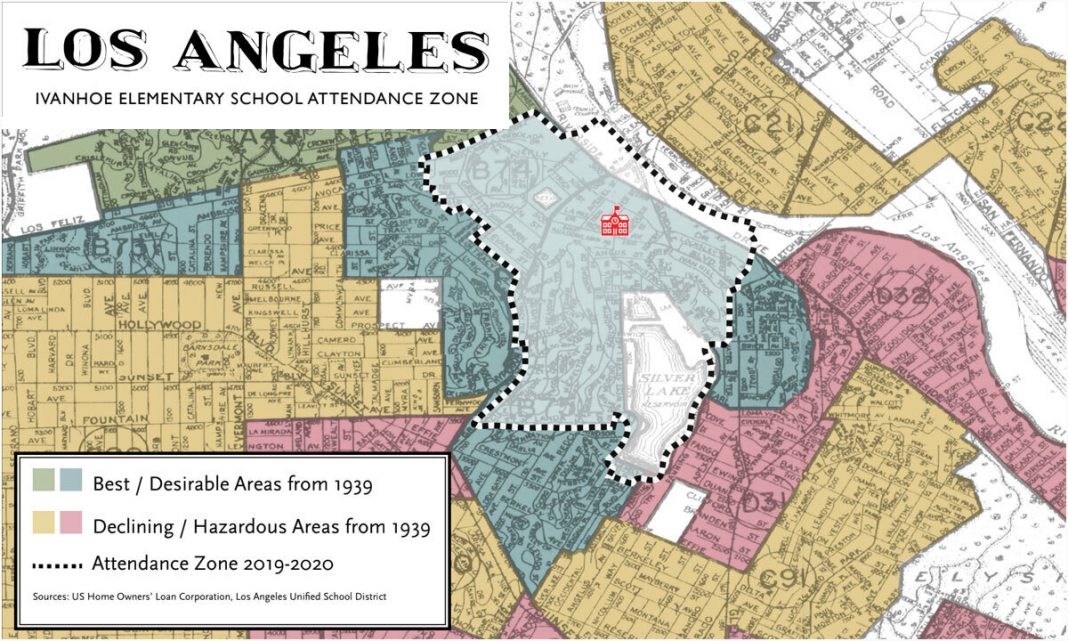If you’re a white student in a Los Angeles elementary school, the odds are stacked against you. Your chances of attending a school in which 7 out of 10 of your classmates can read at grade level are only 40%. That’s less than even odds. Asian students have it even worse: Only 29% attend a school where 7 out of 10 students are reading at grade level.
But look at the odds you face if you’re not white or Asian. In L.A, only 3% of Hispanic elementary students and 4% of Black students attend a school where 7 of 10 kids are reading at grade level. This shocking data comes from the California Department of Education.
Get stories like this delivered straight to your inbox. Sign up for The 74 Newsletter
My organization, Available to All, is a nonprofit watchdog that defends equal access to public schools. Our analysis of state data shines a light on the 456 zoned elementary schools in the Los Angeles Unified School District, the K-5 or K-6 schools that are the default assignment for hundreds of thousands of L.A. children. Over 190,000 children attended these schools in 2023-24, the last year for which data is available. Of these 456 schools, only 39 have 70% of their students reading at grade level. At 105 of these schools, fewer than 30% of kids are reading proficiently.
What is absolutely crucial to understand is that discrepancies of this size can exist only if a government entity enforces them. Imagine for a moment two post offices. At one, 70% of letters and packages get delivered as promised. It’s not great, but we’ll call it pretty good. At the other post office, 3 out of 4 packages get lost or damaged, and only 25% arrive on time and in their original condition.
As soon as this data became public, people would stop going to the bad post office. Hundreds of people would drive to the pretty good post office, even if it was much farther away. Long lines would form outside the door. The bad post office would have to improve or face an empty lobby.
So the question is this: How does LAUSD enforce these discrepancies? How does it prevent tens of thousands of families from lining up outside the doors of those few elementary schools where most of the kids can read? The answer is attendance zones. The district draws a meandering line around each elementary school, determining who is and who isn’t allowed to attend.
Public Schools Violate Their Sacred Mission When They Turn Students Away
The problem is, of course, that these coveted schools are located in some of the priciest parts of town. The lines typically encircle expensive single-family homes that are on large lots. What’s more, the home prices in these zones are distorted because the house comes with exclusive access to a desirable public school. “I know it sounds expensive,” the real estate agent will say, “but if you buy a home in this zone, you won’t have to pay for private school.”
These are quasi-private schools for wealthy Angelenos, but they’re operated on the public’s dime. Our research has shown that Los Angeles is one of many cities where coveted elementary schools have attendance zones that mirror the racist redlining maps from the 1930s. Once again, families in less wealthy areas are boxed out, especially African-American and Hispanic kids, as well as working- and middle-class people of all races.
What’s incredible is that such exclusivity is possible in a system that has so many half-empty schools. Almost half of L.A.’s elementary schools — 225 of 456 — have seen enrollment drop by more than 50% in the last 15 years. You would expect that, with so much overcapacity, families would have their pick of public schools.
How LAUSD School Zones Perpetuate Educational Inequality, Ignoring ‘Redlining’ Past
Even the highest-performing schools are below their full capacity. In the 39 elementary schools with over 70% of kids reading at grade level, enrollment is down by over 7,000. That’s 7,000 seats that could be available to students who are currently assigned to failing schools, often within a mile or two.
California’s 1994 Open Enrollment law requires the district to make open seats available to students who live outside school attendance zones. But LAUSD has treated this policy as voluntary, telling principals as recently as 2018 that it is their choice whether to report open seats. Thus, these 39 schools reported only 58 open seats for this school year — less than 2% of what we’d expect to see based on their historical enrollment.
Of the 39 high-performing elementary schools, 15 of them are “affiliated conversion charters,” meaning they are operated by LAUSD but don’t have to participate in Open Enrollment. However, they are required by the state’s charter school law to hold a lottery for any open seats. My organization called each of these schools, and 14 indicated that they could not accept any applicants from outside the zone, since they were “full.” But, again, these schools are well below their historical peak enrollment and should have at least 2,589 seats available.
The hard truth is this: Principals in these high-performing, zoned schools do not seem to want to make their open seats available to children outside the zone. Doing so might threaten the exclusive nature of the school, and that exclusivity is exactly what families are paying for when they take out their oversized mortgages.
Segregation Forever? What Supreme Court Failed to Do in ‘Brown v. Board’ Ruling
But it doesn’t have to be this way. In the 20 years since Hurricane Katrina, New Orleans has abolished attendance zone assignments. Test scores are up, as are graduation rates and college enrollment. In California, the state legislature ended geographic assignment for community colleges in the 1980s. In the years after this reform, enrollment rebounded after years of decline. Today, the community college system is a crown jewel of the state, championed by Republicans and Democrats alike.
America was built on the idea that even a kid from the wrong side of the tracks can go on to become a business owner, a doctor, a politician, a professor or a general in the military. History has proven that to be true. But here in the 21st century, middle-class and low-income kids are blocked from fulfilling their potential, locked out of the best public schools — even ones that their families’ tax dollars pay for. It’s not fair, it’s not just,and it’s time to make a change.

